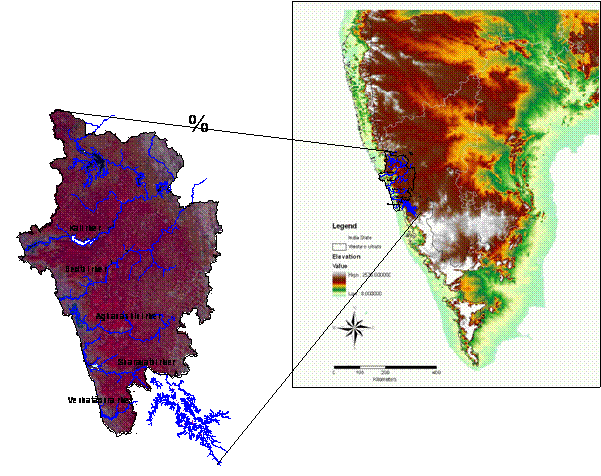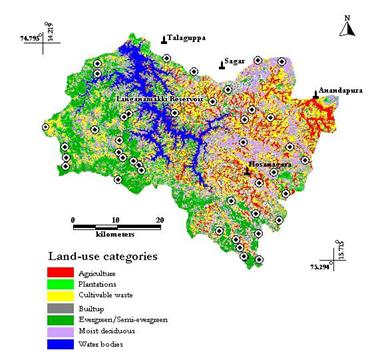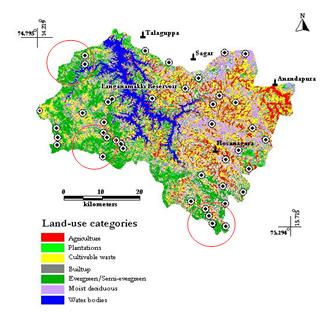
Influence Of Land-Use Changes In River Basins On Diversity And Distribution Of Amphibians |
||
| Back | Gururaja K.V., Sameer Ali, and Ramachandra T.V.* |
Next |
Land-use changes influence local biodiversity directly, and also cumulatively, contribute to regional and global changes in natural systems and quality of life. Consequent to these, direct impacts on the natural resources that support the health and integrity of living beings are evident in recent times. The Western Ghats being one of the global biodiversity hotspot, is reeling under the tremendous pressure from human induced changes in terms of developmental projects like hydel or thermal power plants, big dams, mining activities, unplanned agriculture practices, monoculture plantations, illegal timber logging, etc. This has led once contiguous forest habitats to fragmented patches, which in turn led to shrinkage of original habitat for the wildlife, change in the hydrological regime of the catchment, decreased inflow in streams, human-animal conflicts, etc. Under such circumstances, a proper management practice is called for requiring suitable biological indicators to show the impact of these changes, set priority regions and in developing models for conservation planning. Amphibians are regarded as one of the best biological indicators due to their sensitivity to slightest changes in the environment and could be used as surrogates in conservation and management of practices. They are the predominating vertebrates with high degree of endemism (78%) in Western Ghats . The present study is an attempt to bring in the impacts of various land-uses on anuran distribution in three river basins. Sampling was carried out for amphibians during all seasons of 2003-2006 in basins of Sharavathi, Aghanashini and Bedti. There are as many as 46 species in the region, one of which is new to science and nearly 59% of them are endemic to the Western Ghats . They belong to nine families, Dicroglossidae being represented by 14 species, followed by Rhacophoridae (9 species) and Ranidae (5 species). Species richness is high in Sharavathi river basin, with 36 species, followed by Bedti 33 and Aghanashini 27. The impact of land-use changes, was investigated in the upper catchment of Sharavathi river basin. Species diversity indices, relative abundance values, percentage endemics gave clear indication of differences in each sub-catchment. Karl Pearson's correlation coefficient (r) was calculated between species richness, endemics, environmental descriptors, land-use classes and fragmentation metrics. Principal component analysis was performed to depict the influence of these variables. Results show that sub-catchments with lesser percentage of forest, low canopy cover, higher amount of agricultural area, low rainfall have low species richness, less endemic species and abundant non-endemic species, whereas endemism, species richness and abundance of endemic species are more in the sub-catchments with high tree density, endemic trees, canopy cover, rainfall and lower amount of agriculture fields. This analysis aided in prioritising regions in the Sharavathi river basin for further conservation measures.
Land-use changes as an aftermath of ad-hoc decisions aimed at meeting the needs of human population is considered to be a paramount factor inthe decline of biodiversity all over the world. They not only reduce biodiversity of a region, but over time and space, influence on natural resources, hydrology, nutrition cycle, natural habitat, etc. In an area of rapid land-use changes and in an era of mass extinctions, conservation and management of biodiversity is a Herculean task, especially in the species rich tropical region, where the human dependencies on the natural resources are also more.
Similar situation prevails in the Western Ghats of India, one of the tropical biodiversity hotspots rich with fauna and flora. It forms about 6% of India 's landmass, but harbours more than 30% of all vertebrate and plant species of India . It is a mountain belt having spread of about 1600 km in length, 100 km in width and with altitudes ranging from 300-2700 m msl along the west coast of India (8°N-21°N). The region has varied forest types from tropical evergreen to deciduous to high altitude sholas. It is also an important watershed for the peninsular India with as many as 37 west flowing rivers, three major east flowing rivers and innumerable tributaries. The richness and endemism in flora and fauna of this region is well established with over 4,000 species of flowering plants (38% endemics), 330 butterflies (11% endemics), 289 fishes (41% endemics), 135 amphibians (78% endemics), 157 reptiles (62% endemics), 508 birds (4% endemics) and 137 mammals (12% endemics). This mountain stretch has influenced regional tropical climate, hydrology and vegetation and endemic plant species.
To a certain extent bringing in biodiversity rich regions under the protected area network viz., national parks and sanctuaries have helped in conservation, but most often they are ad-hoc decisions and not based on systematic studies. In such situations, it becomes imperative that one needs to look for biological indicator species that surrogates for other species and habitat of the region, which ultimately helps in prioritizing the conservation areas of a region. Amphibians, the vertebrates with dual life stage are regarded as one of the best biological indicators due to their sensitivity to slightest changes in the environment and used as surrogates in conservation and management practices.
The present paper deals with the following objectives
• to map the diversity and distribution of amphibian species of the region
• to understand the relationship of amphibian diversity with landscape variables
• to prioritize areas of conservation using this relationship
Materials and methods
Study area
Three river basins, namely Bedti, Aghanashini and Sharavathi in the Central Western Ghats (between 12°-16°N) were considered for the this study as depicted in Figure 1. These rivers are west flowing rivers and form the part of Uttara Kannada, the district with highest forest cover (78%) in Karnataka.

Figure 1. False colour composite image of Uttara Kannada district - study area in the Western Ghats.
River Bedti originates at Dharwad District as Shalmala and confluences at Kalghatgi with another stream from Hubli, flows westward for about 161km to merge with Arabian sea . It has a catchment of about 3878sq.km. Similarly, river Sharavathi originates near Ambuthirtha of Shimoga district, traverses for about 132km and confluences at Honnavar to the Arabian sea . The magnificent waterfall, Jog, is situated in the course of this river. The catchment area of this river is about 3005 sq.km. These two rivers originate in neighbouring districts, but more than 60% of their drainage networks are within Uttara Kannada district. River Aghanashini having a catchment of about 1390.52 sq.km traverses westward for about 121km from the origin at Manjguni of Uttara Kannada itself and confluences with Arabian Sea at Tadri. Though the catchment of all these river basins have the influence of land-use change, it is more evident in the catchments of River Sharavathi, where four hydel projects have came up since 1930s. Similar situations are expected in Aghanashini, as a thermal power plant is expected at Tadri and in Bedti, with numerous expansions of road networks, transmission lines etc. To study the influence land-use changes, upper catchment area of 1991.43 sq. km of Sharavathi River basin is considered (Figure 2)

Figure 2. Classified image of Sharavathi upper catchment. Dark circles indicate sampling localities.
Sampling methods
For amphibians
Since 2003, systematic surveys of amphibians are carried out in the entire district in all seasons. Visual encounters, calls, tadpoles, foam nests, spawn are used to record the amphibians in the field. Two man hours of searching is made using torch lights between 19:00-20:00 hr, by walking across the streams, forest floors, gleaning leaf litters, prodding bushes, wood logs, rock crevices etc. All the species encountered are identified up to species level (if not up to genus level) using the keys of Bossuyt and Dubois (2001) and Daniels (2005). Opportunistic encounters are also recorded to enlist the species of the region.
Environmental descriptors
Rainfall data are collected from the nearest rain gauge station for past twenty years. Mean annual rainfall for this period is considered for the analysis. For canopy coverage, densio-meters are used. Stream flow is graded on the basis of water persistence in the entire year. Vegetation sampling were carried out calculate percentage tree endemics and evergreenness of the sub-catchments.
Land-use and fragmentation metrics
Land-use classification was carried out through supervised classification technique of remote sensing data based on Gaussian Maximum Likelihood algorithm. Satellite imageries from IRS 1C MSS ( Indian Remote Sensing Satellite 1C - Multi Spectral Sensor of 23.5m resolution) of November 2000 were used for land-use analyses. The land-use categories considered were evergreen to semi-evergreen forests, moist deciduous forests, plantations, agricultural land and the open land. FRAGSTATS (McGarigal and Marks, 1995), a landscape spatial pattern analysis software is used determine the total edge, edge density, landscape shape index, contiguous forest patch and Shannon 's index. We used forest fragmentation index of Hurd et.al., (2002) to measure the forest fragmentation in the region.
Statistical Analysis
Diversity indices were calculated for amphibian species abundance. Correlation coefficients (r) were calculated to measure the relationships between various environmental descriptors with the species data. A multivariate analysis, PCA was performed to see the influence of these environmental descriptors in the sub-catchments of the study area.
Results
Amphibian diversity and distribution
There were as many as 46 species of amphibians recorded from the entire study region. This is nearly 34% of observed amphibians from the Western Ghats . Among these, one species is new to science and 59% are endemic to the Western Ghats . List of species recorded from the study area detailed in Table 1. All these species belong to nine families, of which Dicroglossidae and Rhacophoridae more species (14 and 9 respectively) followed by Ranidae (5 species). Species richness is high in Sharavathi river basin, with 36 species, followed by Bedti 33 and Aghanashini 27.
Table 1. Species diversity in the three river basins of Uttara Kannada district.
| Aghanashini | Sharavathi | Bedti | Endemic | GAA | |
| Family: Bufonidae | |||||
| Bufo melanostictus | + | + | + | LC | |
| Bufo scaber | + | + | + | LC | |
| Bufo sp . | + | ||||
| Pedostibes tuberculosus | + | + | + | + | EN |
| Family: Microhylidae | |||||
| Ramanella montana | + | + | NT | ||
| Sub-family: Microhylinae | |||||
| Kaloula pulchra | + | LC | |||
| Microhyla ornata | + | + | LC | ||
| Microhyla rubra | + | + | LC | ||
| Family: Micrixalidae | |||||
| Micrixalus fuscus | + | + | NT | ||
| Micrixalus gadgili | + | + | EN | ||
| Micrixalus saxicola | + | + | + | VU | |
| Family: Petrapedatidae | |||||
| Indirana beddomii | + | + | + | + | LC |
| Indirana semipalmatus | + | + | + | + | LC |
| Family: Dicroglossidae Sub-family: Dicroglossinae | |||||
| Euphlyctis cyanophlyctis | + | + | + | LC | |
| Euphlyctis hexadactylus | + | LC | |||
| Fejervarya brevipalmatus | + | + | + | DD | |
| Fejervarya keralensis | + | + | + | + | LC |
| Fejervarya limnocharis | + | + | + | LC | |
| Fejervarya syhadrensis | + | + | + | LC | |
| Fejervarya sp . | + | ||||
| Hoplobatrachus crassus | + | LC | |||
| Hoplobatrachus tigerinus | + | + | LC | ||
| Minervarya syhadris | + | + | + | EN | |
| Minervarya sp . | + | ||||
| Sphaerotheca breviceps | + | + | + | LC | |
| Sphaerotheca rufescens | + | + | + | + | LC |
| Sphearoteca dobsonii | + | LC | |||
| Family: Rhacophoridae Sub-family: Rhacophorinae | |||||
| Philautus cf.leucorhinus | + | + | + | + | EX |
| Philautus cf.luteolus | + | + | + | + | VU |
| Philautus cf.nasutus | + | + | + | EX | |
| Philautus cf.ponmudi | + | + | + | VU | |
| Philautus tuberohumerus | + | + | + | + | VU |
| Polypedates leucomystax | + | LC | |||
| Aghanashini | Sharavathi | Bedti | Endemism | GAA | |
| Polypedates maculatus | + | + | LC | ||
| Polypedates pseudocruciger | + | + | + | LC | |
| Rhacophorus malabaricus | + | + | + | LC | |
| Family: Nyctibatrachidae | |||||
| Nyctibatrachus cf. aliciae | + | + | + | + | EN |
| Nyctibatrachus major | + | + | + | + | VU |
| Nyctibatrachus cf. petraeus | + | + | + | EN | |
| Family: Ranidae | |||||
| Clinotarsus curtipes | + | + | + | NT | |
| Hydrophylax malabaricus | + | + | LC | ||
| Sylvirana aurantiaca | + | + | + | VU | |
| Sylvirana sp. | + | ||||
| Slyvirana temporalis | + | + | + | NT | |
| Family: Ichthyophiidae | |||||
| Ichthyophis beddomi | + | + | LC | ||
| Ichthyophis malabaricus | + | + | LC | ||
| Species richness | 27 | 36 | 33 | 24 | |
Note: E-endemic; NE-non-endemic; GAA-Global Amphibian Assessment; EX-Extinct from type locality; EN-Endangered; Vu-Vulnerable; NT-Near threatened; LC-Least concerned, DD-Data deficient
Number of endemic species varied among the river basins, highest being in Sharavathi with 21 species, followed by Bedti with 24 and Aghanashini with 14 species. Overall 2 species are extinct from the type locality, 5 species are endangered and 6 are vulnerable. Sharavathi and Aghanashini harbours both extinct species, while Bedti harbours one. Four endangered and all six vulnerable species are found in Sharavathi, where as in Aghanashini and Bedti, this amounts to 3,4 and 4,5 respectively.
Environmental descriptors and amphibian diversity
Table 2 details the correlation coefficient (r) at statistically significant level (P <0.05) for endemic species richness and abundance with environmental descriptors, land-use, fragmentation and landscape metrics. Endemic species richness is positively influenced by tree endemism; tree evergreenness; stream flow; canopy and rainfall. Similar among the land-use categories, evergreen-semi-evergreen has exhibited positive correlation with endemic species richness and abundance. The landscape metrics also have influenced species richness. Among the negatively influencing factors, agriculture, open-lands and moist-deciduous categories reduce both endemic richness as well as abundance. Similarly, patch forest negatively influences the richness and abundance.
Table 2. Correlation coefficient (r) at significance level (P<0.05) between endemic species richness and abundance with environmental descriptors, land-use, fragmentation and landscape metrics.
| Endemic species richness | Endemic abundance | |
| Environmental descriptors | ||
| Tree endemism (%) | 0.513 | |
| Evergreenness (%) | 0.544 | |
| Stream flow (%) | 0.817 | 0.607 |
| Canopy (%) | 0.643 | 0.580 |
| Rainfall (mm) | 0.892 | 0.700 |
| Land-use (%) | ||
| Evergreen–semievergreen (%) | 0.853 | 0.617 |
| Moist deciduous (%) | -0.737 | -0.735 |
| Agriculture (%) | -0.734 | -0.585 |
| Open land (%) | -0.783 | -0.659 |
| Forest fragmentation index | ||
| Interior (%) | 0.635 | |
| Patch (%) | -0.709 | -0.577 |
| Landscape pattern metrics | ||
| Shape index | 0.791 | |
| Contiguous patch (m 2 ) | -0.809 | |
| Shannon 's index | 0.842 | 0.618 |
| Total edge (m) | 0.832 | 0.551 |
| Edge density (#/area) | 0.715 | |
Relationships among the environmental descriptors
Table 3 details the correlation coefficient at statistically significant level between various environmental descriptors. It is clear from the table that the variables that influence endemic species and abundance also influence each other. In order to project the influence of all these variables in reduced space, Principal Component Analysis, a multivariate analysis is run using MVSP3.2. Figure 3 depicts the plot of Principal Axis 1 and 2, with the variables and sub-catchments. Principal Axis 1 explains for 86.13% of the variability and Axis 2 for 7.59%. Table 4 gives the Principal Component loading on Axis 1 and 2.
Table 3. Correlation coefficient (r) at significance level (P<0.05) among the environmental descriptors. 1. Tree endemism; 2. Evergreenness; 3. Stream flow; 4. Canopy; 5. Rainfall; 6. Evergreen-semievergreen; 7. Moistdeciduous; 8. Agriculture; 9. Open land; 10. Interior; 11. Perforated; 12. Patch; 13. Shape index; 14. Contiguous patch; 15. Shannon 's index; 16. Total edge; 17. Edge density
1 |
2 |
3 |
4 |
5 |
6 |
7 |
8 |
9 |
10 |
11 |
12 |
13 |
14 |
15 |
16 |
|
| 2 | 0.985 |
|||||||||||||||
| 3 | 0.812 |
0.855 |
||||||||||||||
| 4 | 0.675 |
0.704 |
0.628 |
|||||||||||||
| 5 | 0.791 |
0.824 |
0.973 |
0.749 |
||||||||||||
| 6 | 0.858 |
0.878 |
0.965 |
0.771 |
0.992 |
|||||||||||
| 7 | -0.600 |
-0.703 |
-0.800 |
-0.811 |
-0.825 |
-0.797 |
||||||||||
| 8 | -0.667 |
-0.701 |
-0.920 |
-0.888 |
-0.860 |
0.689 |
||||||||||
| 9 | -0.697 |
-0.726 |
-0.866 |
-0.783 |
-0.931 |
-0.922 |
0.755 |
0.845 |
||||||||
| 10 | 0.701 |
0.695 |
0.806 |
0.596 |
0.841 |
0.847 |
-0.543 |
-0.865 |
-0.942 |
|||||||
| 11 | 0.736 |
0.706 |
0.799 |
0.526 |
0.828 |
0.849 |
-0.800 |
-0.885 |
0.962 |
|||||||
| 12 | -0.674 |
-0.694 |
-0.862 |
-0.644 |
-0.895 |
-0.884 |
0.652 |
0.891 |
0.976 |
-0.979 |
-0.928 |
|||||
| 13 | 0.873 |
0.900 |
0.907 |
0.762 |
0.925 |
0.952 |
-0.757 |
-0.697 |
-0.817 |
0.711 |
0.765 |
-0.753 |
||||
| 14 | -0.870 |
-0.894 |
-0.906 |
-0.759 |
-0.918 |
-0.941 |
0.782 |
0.690 |
0.761 |
-0.633 |
-0.682 |
0.687 |
-0.978 |
|||
| 15 | 0.831 |
0.864 |
0.923 |
0.754 |
0.934 |
0.944 |
-0.818 |
-0.719 |
-0.773 |
0.630 |
0.665 |
-0.701 |
0.965 |
-0.994 |
||
| 16 | 0.812 |
0.858 |
0.896 |
0.722 |
0.907 |
0.921 |
-0.802 |
-0.683 |
-0.752 |
0.614 |
0.661 |
-0.671 |
0.977 |
-0.973 |
0.969 |
|
| 17 | 0.935 |
0.943 |
0.906 |
0.770 |
0.917 |
0.956 |
-0.714 |
-0.721 |
-0.837 |
0.770 |
0.814 |
-0.794 |
0.978 |
-0.960 |
0.941 |
0.921 |
Table 4. Variable loadings of Principal Component Analysis performed for environmental descriptors.
Variable loadings |
PC 1 |
PC2 |
| Tree endemism (%) | 0.233 |
0.194 |
| Tree evergreenness (%) | 0.282 |
0.231 |
| Stream flow (%) | 0.257 |
-0.087 |
| Canopy (%) | 0.086 |
0.101 |
| Rainfall (mm) | 0.191 |
-0.049 |
| Evergreen-Semi-evergreen (%) | 0.509 |
-0.015 |
| Moist-deciduous (%) | -0.101 |
-0.038 |
| Agriculture (%) | -0.373 |
0.657 |
| Open land (%) | -0.133 |
0.124 |
| Interior forest (%) | 0.178 |
-0.304 |
| Perforated forest (%) | 0.101 |
-0.122 |
| Patch forest (%) | -0.143 |
0.218 |
| Shape index | 0.214 |
0.2 |
| Contiguous forest (m 2 ) | -0.157 |
-0.169 |
| Shannon 's index | 0.254 |
0.232 |
| Total edge (m) | 0.364 |
0.404 |

Figure 3. Biplot of Principal Component Analysis performed for environmental descriptors. 1. Nandihole, 2. Haridravathi, 3. Mavinhole, 4. Sharavathi, 5. Hilkunji, 6. Hurli, 7. Nagodi and 8. Yennehole.

Figure 4. Conservation priority zones in Sharavathi river basin. 1. Muppane, 2. Vallur and 3. Niluvase.
For conservation priority regions, we demarcated the three important regions based on the amphibian endemic species diversity, environmental descriptors, land-use and fragmentation metrics. Figure 4 depicts the three regions. Region 1 falls in the protected area of Muppane reserve forest, 2 in Vallur region where as 3 in Niluvase. The latter two does not come under protected area. This has substantiated the earlier view that protected areas do not effectively serve the purpose amphibian conservation. Hence, we propose these areas also to be covered for conservation on priority. It was very evident from our study that regions with more human induced changes in land-uses, canopy cover, hydrological regimes often provided shelter to generalist amphibian species, where as the remnant forest patches with higher amount of canopy and vegetation had more endemic species. This again stresses the point that, amphibian habitats are being invariably fragmented and destroyed, though many more species are yet to be described from this region and whose future are really in danger, calling for such researches across Western Ghats to conserve and understand them better.
Acknowledgements
We would like to thank Karthick B, Vishnu D Mukri, Sreekantha, Shrikant, Lakshminarayana for their help in the field. We also thank Karnataka Forest Department for necessary permissions to carryout the research work.
References